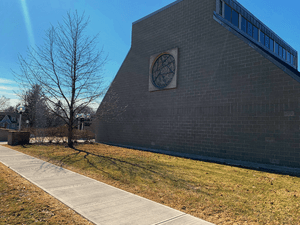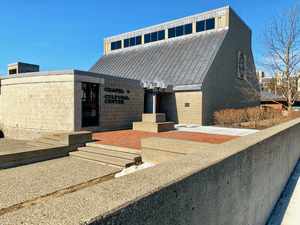Chapel + Cultural Center at Rensselaer facts for kids
Quick facts for kids Christ Sun of Justice |
|
|---|---|
| University Parish of Christ Sun of Justice | |
 |
|
| Location | 2215 Burdett Avenue Troy, New York |
| Country | United States |
| Denomination | Roman Catholic |
| History | |
| Status | Active |
| Founded | 1907 |
| Consecrated | 1970 |
| Administration | |
| Diocese | Albany |
| Province | New York |
The Chapel + Cultural Center at Rensselaer, often called "The C+CC," is a special building in Troy, New York. It's known for its unique design and serves many purposes. The "+" sign in its name is a symbol for the Christian cross.
The C+CC is owned and run by the Rensselaer Newman Foundation (RNF). Even though it's on the campus of Rensselaer Polytechnic Institute (RPI), it operates independently. The C+CC is home to the Roman Catholic University Parish of Christ Sun of Justice. Its staff also helps support religious services for Catholic, Protestant, Jewish, and Muslim students at RPI.
How the C+CC Began
The Catholic community at RPI started in 1907 as a "Newman Association." These groups, named after Cardinal Newman, help Catholic students at non-Catholic universities.
In 1914, a part-time priest was assigned to RPI. Later, in 1936, Monsignor William M. Slavin became the first full-time Catholic Chaplain. Reverend Thomas W. Phelan took over in 1959.
By the early 1960s, the Catholic community needed its own space. Their old chapel was sold to RPI. So, in 1963, the Rensselaer Newman Foundation (RNF) was officially created. This non-profit group aimed to raise money and build a new facility.
The RNF had several goals:
- To offer courses in religion and philosophy.
- To create extra programs for Catholic students at RPI.
- To provide scholarships and other help for students.
- To support the intellectual and moral growth of Catholic students through religious education and cultural activities.
In 1965 and 1966, the RNF bought land in Troy to build the C+CC. The design for the building was finished by February 1967. Construction began in June 1967, and the C+CC officially opened with a celebration in late 1968.
In 1970, the University Parish of Christ Sun of Justice was officially formed. Reverend Thomas W. Phelan became its first pastor. He served until 2001. Many other priests and staff members have served the C+CC since then.
The C+CC Building Design
The C+CC was designed to be a very flexible building. It brings together religious services, performing arts, and educational events. It's known for its simple, unfinished block design and how easily it can be adapted for different uses.
When it opened, many national and international magazines wrote about the C+CC. They praised its unique design and how it blended different functions. It even won a top award for religious buildings.
A book called Community on Campus was written about the C+CC in 1971. It said that the C+CC's multi-purpose design was a big step forward for the Catholic Church in America. It showed how the Church was changing to be more open and involved in the modern world.
The C+CC has a large main auditorium that can hold up to 450 people. It has movable seating, so it can be set up in many ways for different events. There's also an altar chapel that can be connected to or separated from the auditorium using sliding wooden doors.
Many artists contributed to the building's unique features:
- Ade Bethune designed the altar chapel and the beautiful stained glass oculus (a round window) in the east wall.
- Father Edward Catich painted giant Greek, Roman, and Hebrew alphabets on the main auditorium's floor.
- A large piece of a crucifix carved by Eric Gill hangs near the oculus.
The C+CC also has a collection of art from famous artists like Pablo Picasso, Tomie dePaola, and George Nakashima.
There's an art gallery in the hallway, a lounge, and a meeting room for exhibitions and community gatherings. The building also includes a rectory, called "Slavin House," where the priests and staff live. In 1994, efforts began to improve the building and make it fully accessible for people with disabilities.
In 2003, the street outside the C+CC was renamed "Tom Phelan Place." This honored Reverend Phelan's long service to the community. Reverend Phelan passed away in 2006.
In 2011, the C+CC building was added to the National Register of Historic Places. This means it's recognized as an important historical site.


